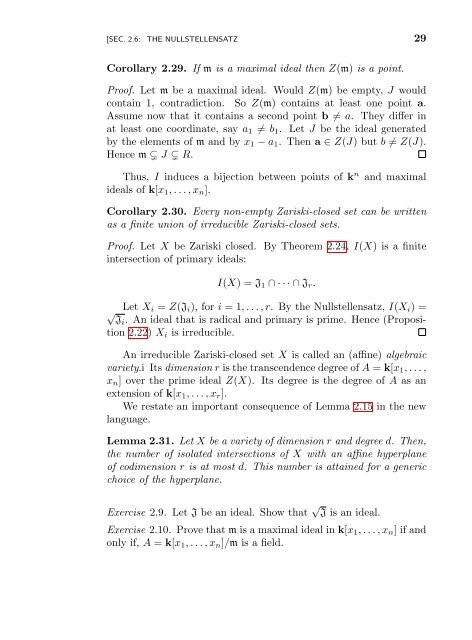Nonlinear Equations - UFRJ
Nonlinear Equations - UFRJ
Nonlinear Equations - UFRJ
Create successful ePaper yourself
Turn your PDF publications into a flip-book with our unique Google optimized e-Paper software.
[SEC. 2.6: THE NULLSTELLENSATZ 29<br />
Corollary 2.29. If m is a maximal ideal then Z(m) is a point.<br />
Proof. Let m be a maximal ideal. Would Z(m) be empty, J would<br />
contain 1, contradiction. So Z(m) contains at least one point a.<br />
Assume now that it contains a second point b ≠ a. They differ in<br />
at least one coordinate, say a 1 ≠ b 1 . Let J be the ideal generated<br />
by the elements of m and by x 1 − a 1 . Then a ∈ Z(J) but b ≠ Z(J).<br />
Hence m J R.<br />
Thus, I induces a bijection between points of k n and maximal<br />
ideals of k[x 1 , . . . , x n ].<br />
Corollary 2.30. Every non-empty Zariski-closed set can be written<br />
as a finite union of irreducible Zariski-closed sets.<br />
Proof. Let X be Zariski closed. By Theorem 2.24, I(X) is a finite<br />
intersection of primary ideals:<br />
I(X) = J 1 ∩ · · · ∩ J r .<br />
Let X i = Z(J i ), for i = 1, . . . , r. By the Nullstellensatz, I(X i ) =<br />
√<br />
Ji . An ideal that is radical and primary is prime. Hence (Proposition<br />
2.22) X i is irreducible.<br />
An irreducible Zariski-closed set X is called an (affine) algebraic<br />
variety.i Its dimension r is the transcendence degree of A = k[x 1 , . . . ,<br />
x n ] over the prime ideal Z(X). Its degree is the degree of A as an<br />
extension of k[x 1 , . . . , x r ].<br />
We restate an important consequence of Lemma 2.15 in the new<br />
language.<br />
Lemma 2.31. Let X be a variety of dimension r and degree d. Then,<br />
the number of isolated intersections of X with an affine hyperplane<br />
of codimension r is at most d. This number is attained for a generic<br />
choice of the hyperplane.<br />
Exercise 2.9. Let J be an ideal. Show that √ J is an ideal.<br />
Exercise 2.10. Prove that m is a maximal ideal in k[x 1 , . . . , x n ] if and<br />
only if, A = k[x 1 , . . . , x n ]/m is a field.

















